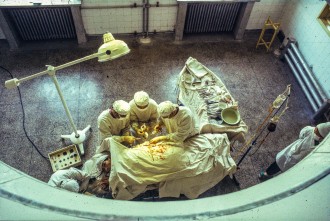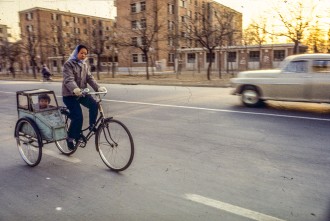-

View from the luxury hotel Broadway Mansoins over to the Pudong district (barely built on in 1978)
-

Truck driver somewhere near Beijing, 1978
-

Grandmother with "bound", crippled feet in a people's commune "Evergreen" near Beijing, 1978
-

Residents of a model people's commune demonstrate determination in the "anti-imperialist struggle", 1978
-

Acupuncture practice in the provincial hospital of Zhengzhou, 1978
-

In the provincial hospital of Zhengzhou we are allowed to observe an operation under acupuncture anesthesia through a dome, 1978
-

During spinal cord surgery, the patient is observed under acupuncture anesthesia, Zhengzhou 1978
-

Simple street canteen in Beijing, steamed jiaozi or dumplings and beer from a bucket, 1987
-

Bicycles with sidecars were frequently seen on the streets of Beijing, 1987
-

In 1978, Beijing had just three high-rise buildings in the middle of a network of single-story courtyard houses (hutongs)
-

The bicycle was also dominant on the major boulevards, Beijing 1978
-

Agitprop group sings songs about the benefits of the revolution in an overland train, 1978
-

In a display case, people currently sentenced to death are shown shortly before execution, 1978
-

Model house in the rural commune "The East is glowing" near Beijing, 1978
-

Engine power is rare, workers pull their construction machines to the next building site; Nanjing 1978
-

Elementary school "The East is glowing" in the countryside near Beijing, 1978
-

Visit to a factory for the blind in Shanghai, 1978
-

Rice fields in the river plain of Guilin, South China 1981
China Travel 1978 Color
in 1978, as a Maoist "believer" for years, I was given the opportunity by a China-loving building contractor to accompany one of the first tourist groups to the Middle Kingdom as a travel assistant. It was two years after Mao's death and the People's Republic of China was the unknown land of the "blue ants". The capital Beijing still consisted of a geometric network of single-storey courtyard houses (hutongs) and in Shanghai, in the later boom district of Pujiang, there were only warehouses. The tour group was mainly presented with showcase communities, but after persistent questioning they were also shown businesses for the disabled. KaJo was fascinated by the people, but he found the dictatorial system under an extremely privileged party structure repulsive and subsequently turned his back on Maoist ideology. in 1980, Karl traveled again as a tour guide for a tour group (via Transsib). On both trips, KaJo worked with both slide film and b/w negative.
